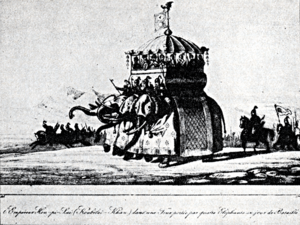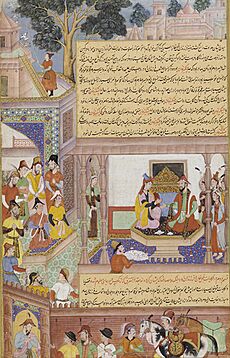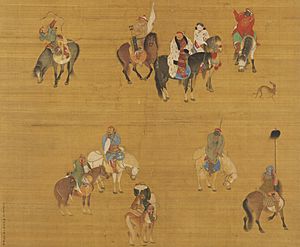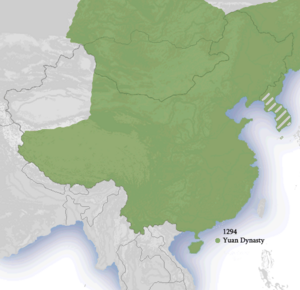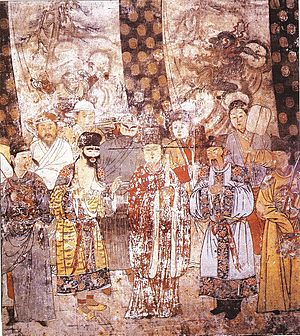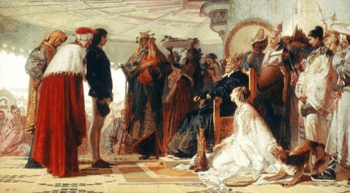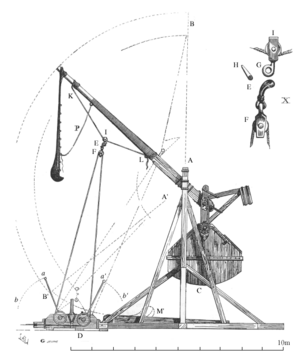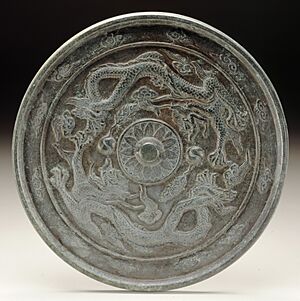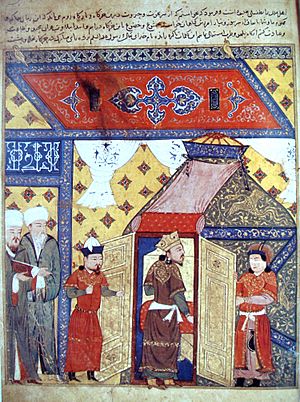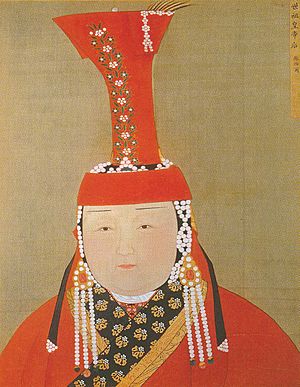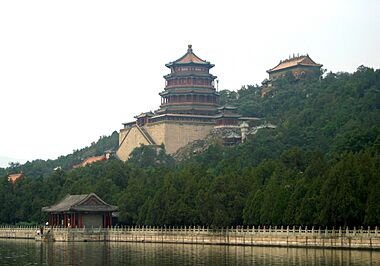Kublai Khan facts for kids
Quick facts for kids Kublai Khan |
|||||||||||||||||||||
|---|---|---|---|---|---|---|---|---|---|---|---|---|---|---|---|---|---|---|---|---|---|
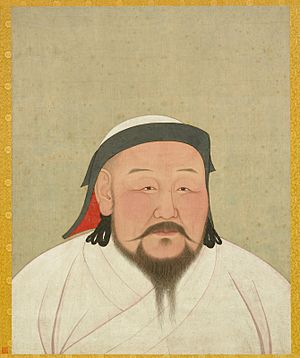
Portrait by artist Araniko, drawn shortly after Kublai's death in 1294.
|
|||||||||||||||||||||
| Khagan of the Mongol Empire | |||||||||||||||||||||
| Reign | 15 April 1260 – 18 February 1294 | ||||||||||||||||||||
| Coronation | 5 May 1260 | ||||||||||||||||||||
| Predecessor |
|
||||||||||||||||||||
| Successor | Empire divided Temür Khan (claimant) |
||||||||||||||||||||
| Emperor of the Yuan dynasty | |||||||||||||||||||||
| Reign | 18 December 1271 – 18 February 1294 | ||||||||||||||||||||
| Successor | Temür Khan | ||||||||||||||||||||
| Born | 23 September 1215 Mongol Empire |
||||||||||||||||||||
| Died | 18 February 1294 (aged 78) Khanbaliq, Yuan dynasty |
||||||||||||||||||||
| Burial | Unknown, presumptively Burkhan Khaldun | ||||||||||||||||||||
| Spouse |
Tegulen Khatun
(m. 1232; died 1233)Empress Chabi
(m. 1234; died 1281)Empress Nambui
(m. 1283; missing 1290) |
||||||||||||||||||||
| Issue | Zhenjin | ||||||||||||||||||||
|
|||||||||||||||||||||
| House | Borjigin | ||||||||||||||||||||
| Dynasty | Yuan (founder) | ||||||||||||||||||||
| Father | Tolui | ||||||||||||||||||||
| Mother | Sorghaghtani Beki | ||||||||||||||||||||
| Religion | Buddhism | ||||||||||||||||||||
Kublai Khan (born September 23, 1215 – died February 18, 1294) was a very important leader. He was a grandson of the famous Genghis Khan. Kublai founded and became the first emperor of the Yuan dynasty in China. This was a Mongol-led empire.
He officially named his dynasty "Great Yuan" in 1271. He ruled China as its emperor until he died in 1294. Kublai was the second son of Tolui and his wife Sorghaghtani Beki. Genghis Khan died in 1227 when Kublai was almost 12 years old.
Kublai took over from his older brother Möngke as the Great Khan in 1260. But he had to fight his younger brother Ariq Böke in a civil war. This war lasted until 1264. This conflict caused the division of the Mongol Empire. Kublai's main power was over the Yuan Empire. However, he still influenced other parts of the Mongol Empire.
By 1279, Kublai's forces had fully conquered the Song dynasty. This made him the first non-Han emperor to rule all of China proper. As emperor, he also ordered invasions of Japan, Vietnam, Burma, and Java.
Contents
Early Life and Learning
Kublai Khan was the fourth son of Tolui. His mother, Sorghaghtani Beki, was a very wise woman. She chose a Buddhist Tangut woman to be Kublai's nurse. Kublai respected this nurse greatly later in his life.
In 1224, when Kublai was nine, his grandfather Genghis Khan held a special ceremony for him. This was after Kublai's first hunt. Genghis Khan said that Kublai's words were "full of wisdom." He told everyone to listen to him.
Genghis Khan died three years later, in 1227. Kublai was 12. His father, Tolui, ruled for two years. Then, Kublai's uncle Ogedei became the Great Khan in 1229.
Early Responsibilities
After the Mongols conquered the Jin dynasty, Ogedei gave land to Tolui's family in 1236. Kublai received his own estate with many households. At first, he let local officials manage things. But their corruption and high taxes made many people flee.
Kublai quickly went to his land and ordered changes. His mother sent new officials to help him. They also changed the tax laws. Because of these efforts, many people who had left came back.
Learning Chinese Culture
A very important part of Kublai's early life was his strong interest in Han culture. He invited Haiyun, a leading Buddhist monk, to his home in Mongolia. In 1242, Kublai asked Haiyun about Buddhist philosophy. Haiyun even named Kublai's son, Zhenjin.
Haiyun also introduced Kublai to Liu Bingzhong. Liu was a painter, poet, and mathematician. He became Kublai's trusted advisor. Kublai also hired people from other groups. He wanted to balance local and empire-wide interests.
Becoming a Leader in China
In 1251, Kublai's older brother Möngke became the Great Khan. Möngke sent Kublai to rule northern China. Kublai moved his main camp to central Inner Mongolia.
As a ruler, Kublai managed his territory well. He helped farming grow in Henan. He also increased spending on social welfare after taking Xi'an. These actions made many Chinese leaders respect him. This support was key to him founding the Yuan dynasty later.
Conquering Dali
In 1253, Kublai was ordered to attack Yunnan. He tried to get the Dali Kingdom to surrender peacefully. But the ruling family refused and killed Mongol messengers.
Kublai's army attacked from different directions. Kublai himself took the capital city of Dali. He spared the people there, even though his messengers had been killed. The Dali emperor joined the Mongols. His troops helped conquer the rest of Yunnan. By 1256, Yunnan was fully under Mongol control.
Buddhist Influence and Challenges
Kublai was interested in Tibetan monks because they were good healers. In 1253, he invited Drogön Chögyal Phagpa from the Sakya school to join him. Phagpa performed a special ritual for Kublai and his wife, Chabi.
Some officials became jealous of Kublai's success. They thought he was trying to build his own empire. In 1257, Möngke Khan sent tax inspectors to check Kublai's officials. They found problems and punished some officials. Kublai went to Möngke in person, and they made up.
Kublai also helped settle a dispute between Daoists and Buddhists. The Daoists had taken over Buddhist temples. Kublai held a meeting in 1258. He ruled against the Daoists. He converted many Daoist temples to Buddhism and destroyed some Daoist texts. Kublai and the Yuan dynasty later favored Buddhism.
In 1258, Möngke put Kublai in charge of an army to attack Sichuan. Kublai was sick but still went to help. In 1259, he learned that Möngke had died. Kublai kept his brother's death a secret. He continued attacking Wuhan.
A Song dynasty official secretly offered Kublai a peace deal. He offered silver and silk if the Mongols would agree to the Yangtze River as a border. Kublai eventually accepted this peace agreement.
Becoming Great Khan
Kublai learned that his younger brother Ariq Böke was gathering troops. Ariq Böke held a kurultai (a Mongol great council) and was named Great Khan. Most of Genghis Khan's family supported him.
Kublai's advisors encouraged him to claim the throne. Many princes in northern China supported him. Kublai held his own kurultai on April 15, 1260. This council also declared Kublai the Great Khan.
This led to a war between Kublai and Ariq Böke. The war damaged the Mongol capital at Karakorum. Kublai cut off food supplies to Karakorum, which helped him take the city. Ariq Böke surrendered to Kublai in 1264. The leaders of other Mongol regions recognized Kublai's victory. Kublai forgave Ariq Böke but punished his main supporters.
During this civil war, a Chinese official named Li Tan rebelled against Mongol rule in 1262. Kublai quickly crushed this revolt. This event made Kublai less trusting of Chinese officials. After becoming emperor, he limited the power of Chinese warlords.
Kublai's Reign
Leading the Mongol Empire
Kublai worked to keep control over the different parts of the Mongol Empire. He appointed new leaders in the Ilkhanate and the Golden Horde. He also tried to make peace between these regions.
Prince Kaidu of the House of Ögedei refused to accept Kublai's rule. Kublai tried to get other leaders to fight Kaidu. This led to ongoing conflicts in the western parts of the Mongol Empire.
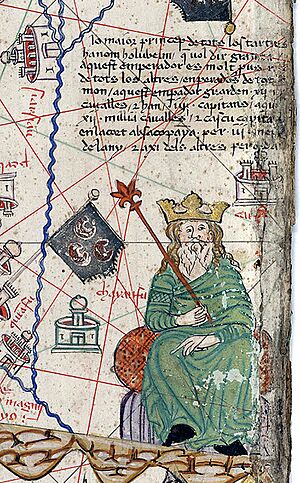
"The most powerful prince of the Tartars is named Holubeim [Kubilay Khan], which means Great Khan. This emperor is richer than any other emperor in the world. This emperor is protected by twelve thousand horsemen with their four captains that stay at the court three months of the year."
Kublai also worked to control the Korean Peninsula. He helped Wonjong of Goryeo become king in 1259. Korea became a "son-in-law" state, meaning its royal family often married into Kublai's family. Korea also provided troops and ships for Mongol campaigns.
In 1260, Kublai sent an advisor to the Song dynasty emperor. He offered the Song some freedom if they surrendered. But the Song emperor refused and imprisoned Kublai's messenger.
Kublai brought engineers from the Ilkhanate to help conquer the Song. After the city of Xiangyang fell in 1273, Kublai launched a final attack on the Song dynasty. He made Bayan of the Baarin the supreme commander.
In 1271, Kublai renamed his Mongol government in China "Dai Yuan." He wanted to rule China in a Chinese way. He moved his capital to Khanbaliq, which is now Beijing. Some traditional Mongols did not like these changes. They felt he was becoming too Chinese. Kaidu used this to gain support against Kublai.
The Song imperial family surrendered to the Yuan in 1276. This made the Mongols the first non-Chinese people to conquer all of China. In 1279, Yuan navy defeated the last Song supporters.
Kublai built a strong empire. He created schools, trade ports, and canals. He also supported science and the arts. Records show that over 20,000 public schools were created during his rule.
Kublai's costly invasions of Vietnam, Sakhalin, Burma, and Champa made these countries his vassals. However, his invasions of Japan (1274 and 1281), the third invasion of Vietnam (1287–88), and the invasion of Java (1293) all failed.
Kublai's nephew, Ilkhan Abaqa, tried to form an alliance with European powers. They wanted to defeat the Mamluks in the Middle East. Kublai focused on foreign alliances and opening trade routes. He met many ambassadors and merchants.
Emperor of the Yuan Dynasty
Kublai focused on ruling China. He adopted Chinese political and cultural ways. He also worked to reduce the power of local lords. He relied on Chinese advisors like Liu Bingzhong and Xu Heng. He also used Buddhist Uyghurs to help run Chinese areas.
Kublai appointed the Sakya lama Drogön Chögyal Phagpa as his Imperial Preceptor. This gave Phagpa power over all Buddhist monks in the empire. In 1270, Phagpa created the 'Phags-pa script. Kublai set up a special commission to manage Buddhist affairs.
In 1271, Kublai officially started the Yuan dynasty. He made Dadu (modern-day Beijing) his capital in 1272. His summer capital was Shangdu (Xanadu). To unite China, Kublai launched a huge attack on the Southern Song dynasty in 1274. He finally destroyed the Song in 1279.
Most of the Yuan empire was divided into provinces. These were run by governors. The central region around Dadu was directly controlled by the government. Tibet was managed by a separate department.
Kublai helped the economy grow. He rebuilt the Grand Canal. He also repaired public buildings and improved highways. He encouraged trade. Muslim, Uyghur, and Chinese merchants expanded their trade into the South China Sea and the Indian Ocean. The government also controlled salt production, which was a major source of income.
The Mongol government had used paper money since 1227. In 1260, Kublai created the first unified paper currency called Jiaochao. These bills had no expiration date. To prevent their value from dropping, they could be exchanged for silver and gold. The government also accepted tax payments in paper money.
In 1273, Kublai issued new paper money to pay for his conquest of the Song. But too much money was printed, leading to inflation. People were required to use paper money. The government even took gold and silver from private citizens and gave them paper notes instead. Kublai Khan is known for being one of the first to use fiat money. Paper money made collecting taxes and running the empire much easier.
Kublai supported Asian arts and allowed different religions. Many Europeans visited his empire. The most famous was the Italian explorer Marco Polo in the 1270s. Marco Polo worked for Kublai for 17 years.
Science and Minority Relations
Many Muslims served as high officials in Kublai Khan's court. Eight of the twelve administrative districts had Muslim governors. One important Muslim governor was Sayyid Ajjal Shams al-Din Omar in Yunnan. He was very knowledgeable in Chinese traditions and helped spread Islam in China.
Kublai Khan supported Muslim scholars and scientists. Muslim astronomers helped build an observatory in Shaanxi. Astronomers like Jamal ad-Din brought new instruments and ideas. These helped improve the Chinese calendar.
Muslim mapmakers created accurate maps of countries along the Silk Road. This greatly increased the knowledge of Yuan dynasty rulers and merchants.
Muslim doctors set up hospitals and medical schools in Beijing and Shangdu. Avicenna's medical works were also published in China during this time.
Muslim mathematicians brought Euclidean Geometry, Spherical trigonometry, and Arabic numerals to China.
Kublai also brought siege engineers Ismail and Al al-Din to China. They invented the "Muslim trebuchet," a powerful weapon used during the Battle of Xiangyang.
Military and Foreign Relations

Kublai created a new imperial bodyguard. It included Chinese, Kipchak, Alan, and Russian soldiers. Mongol and Chinese armies used the same decimal system for organization, like Genghis Khan. The Mongols quickly adopted new weapons and technologies. Kublai's army also learned naval techniques from the Chinese. This helped them conquer the Song dynasty quickly.
Tibet and Xinjiang
In 1285, the Drikung Kagyu sect revolted in Tibet. The Chagatayid Khan, Duwa, helped the rebels. Kublai's grandson Buqa-Temür crushed the rebellion in 1291. Tibet then became fully peaceful under Yuan rule.
Korea Becomes a Vassal
Kublai Khan invaded Goryeo (Korea) in 1260. He made it a "son-in-law" state, meaning it paid tribute and its royal family married into the Mongol imperial family. Goryeo became a Mongol military base. Korean troops and ships helped in Mongol campaigns.
Kublai wanted to invade Japan, Burma, Vietnam, and Java. These costly invasions and the use of paper money caused inflation. The wars against the Song dynasty and Japan greatly increased the amount of paper money in circulation.
Invasions of Japan
Kublai Khan tried to invade Japan twice. Both attempts failed due to bad weather or problems with the ships. The ships were built for rivers, not the open ocean.
The first invasion was in 1274 with 900 ships. The second invasion happened in 1281. Mongols sent two forces: 40,000 troops from Korea and 100,000 troops from southern China. The fleets were built quickly and were not ready for sea travel.
The Mongols easily took Tsushima Island and Iki Island. But the Chinese ships did not arrive on time. Japanese samurai fought bravely. They used walls along the coast to defend against the Mongols. The Mongols were driven back to their ships.
Archaeologists have found shipwrecks from the second invasion. They believe Kublai rushed to build his huge fleet. This forced the Chinese to use any available ships, including riverboats. If Kublai had used strong ocean-going ships, his navy might have succeeded. The failures were very costly and damaged the idea that the Mongols were unbeatable.
Invasions of Vietnam
Kublai Khan invaded Đại Việt (Vietnam) five times between 1257 and 1292. Major campaigns happened in 1258, 1285, and 1287. Some historians see these as successes because Vietnam became a tributary state. But Vietnamese history sees them as major victories against foreign invaders.
The first invasion in 1258 was to find new ways to attack the Song dynasty. The Mongol general Uriyangkhadai captured the Vietnamese capital, Thang Long. By the end of the second and third invasions, Vietnam and Champa agreed to pay tribute to the Yuan dynasty. This helped avoid more fighting.
Southeast Asia and South Seas
Three expeditions against Burma (1277, 1283, 1287) led Mongol forces to the Irrawaddy Delta. They captured Bagan, the capital of the Pagan kingdom. Pagan became a tributary state, sending gifts to the Yuan court.
Kublai Khan also had good relations with Siam. He encouraged them to attack the Khmers. This happened after King Jayavarman VIII of the Khmer Empire refused to pay tribute. The Siamese attacks weakened the Khmer Empire. The Mongols then conquered Cambodia in 1284. Cambodia became a vassal state by 1285.
In his last years, Kublai sent a large naval force to Java (1293). But the Mongol forces had to retreat after heavy losses. By 1294, the year Kublai died, the Thai kingdoms of Sukhothai and Chiang Mai had become vassal states of the Yuan dynasty.
Contact with Europe and Africa
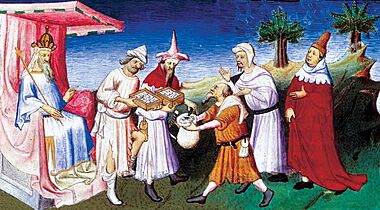
Under Kublai, direct contact between East Asia and Europe began. This was possible because the Mongols controlled trade routes across Central Asia. Many Europeans traveled to China, including merchants and missionaries.
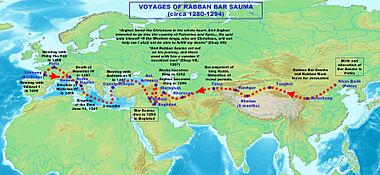
In the 13th century, the Sultanate of Mogadishu in Africa had a good reputation in Asia. Kublai Khan sent an envoy to Mogadishu. The delegation was captured. Kublai then sent another envoy to arrange their release.
Building the Capital City
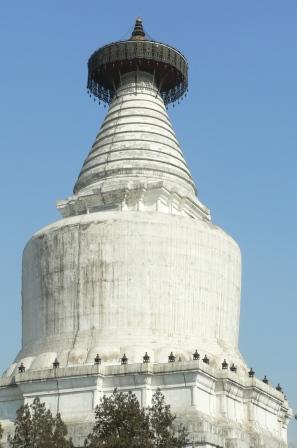
After becoming Great Khan in 1260, Kublai began to organize his country. He sent Zhang Wenqian, a government official, to areas where there was unrest. Zhang was joined by his friend Guo Shoujing. Guo was an expert in engineering and astronomy.
Guo Shoujing built astronomical instruments. These included water clocks and armillary spheres. Kublai also hired foreign artists to build his new capital, Khanbaliq (Dadu). One artist, Araniko from Nepal, built the large White Stupa in the city.
Kublai knew how important water management was for farming and transport. He asked Guo to improve water systems between Dadu and the Yellow River. Guo found a spring and built a 30 km channel to bring water to Dadu. He also built new canals with gates to control water levels. These improvements were very successful. Kublai then asked Guo to work on similar projects across the country.
Nayan's Rebellion
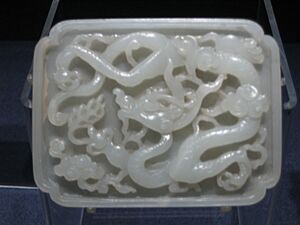
During the conquest of the Jin dynasty, Genghis Khan's younger brothers received large lands in Manchuria. Their descendants supported Kublai at first. But the younger generation wanted more independence.
In 1287, Nayan, a descendant of Genghis Khan's brother, started a revolt. He tried to join forces with Kublai's rival, Kaidu. Many other Mongol princes and local people who had suffered from famine supported Nayan.
Kublai quickly sent his general Bayan to keep Nayan and Kaidu apart. Kublai himself led another army against Nayan in Manchuria. On June 14, Kublai's forces attacked Nayan's soldiers. Kublai's army, including soldiers from Korea, fought hard. Nayan's troops were defeated. Nayan was captured and executed in a traditional Mongol way.
Rebellions by Nayan's supporters continued until 1289. Kublai put down these uprisings firmly. This rebellion made Kublai create a new branch of government in Manchuria.
Later Years
After his beloved wife Chabi died in 1281, Kublai became less involved in daily government. He gave instructions through another of his queens, Nambui.
Kublai's first choice for his successor was his son Zhenjin. Zhenjin managed the dynasty in a Chinese style. But Zhenjin died in 1286, eight years before his father. Kublai was very sad about this loss.
Kublai became increasingly unhappy after the deaths of his wife and chosen heir. The failures of his military campaigns in Vietnam and Japan also troubled him. Kublai ate and drank too much, which may have contributed to his health problems like gout and diabetes. He tried many medical treatments but nothing helped.
Before he died, Kublai chose Zhenjin's son Temür to be the next Great Khan. Kublai Khan died on February 18, 1294, at the age of 78. His body was taken to the burial place of the Khans in Mongolia.
Family
Kublai first married Tegulen, but she died young. Then he married Chabi of the Khongirad clan. She was his most loved empress. After Chabi's death in 1281, Kublai married Chabi's younger cousin, Nambui.
- Empress Tegülün (died 1233)
- Dorji (born around 1233, died 1263), his first son.
- Empress Chabi (1216 – 1281)
- Yuelie, a princess.
- Princess Ulujin.
- Chalun, a princess.
- Zhenjin (1240–1285), his second son and chosen heir.
- Manggala (born around 1242, died 1280), his third son.
- Öljei, a princess.
- Nomughan (died 1301), his fourth son.
- Nangiajin, a princess.
- Kokechi (died 1271), his sixth son.
- Qutugh Kelmysh (1251–1297), a princess who married the King of Goryeo.
- Empress Nambui (disappeared 1294)
- Temuchi, his twelfth son.
Kublai also had other wives and concubines who bore him more children.
Poetry
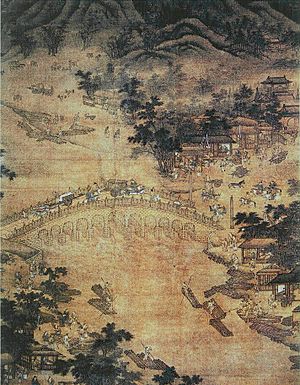
Kublai wrote many Chinese poems, but most are now lost. Only one Chinese poem by him is still known. It is called 'Inspiration recorded while enjoying the ascent to Spring Mountain'.
It is said that Kublai Khan once visited a Buddhist temple in Beijing. On his way back, he climbed Longevity Hill. He felt inspired and wrote this poem.
| Inspiration recorded while enjoying the ascent to Spring Mountain (陟玩春山記興) | ||
|---|---|---|
|
時膺韶景陟蘭峰 |
Shí yīng sháo jǐng zhì lán fēng; |
|
This is translated:
Havar tsagiin nairamduu uliral dor anhilam uulnaa avirlaa |
I ascended on Fragrant Hill in the friendly season of spring |
Kublai Khan's Legacy
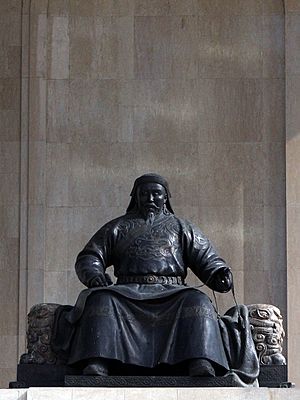
Kublai's rise to power in 1260 changed the Mongol Empire. Even though his rule caused some division among the Mongols, his decision to make his empire part of China brought it global attention.
Kublai and the rulers before him helped create a strong and unified China. The Yuan dynasty's rule over Tibet, Manchuria, and Mongolia from its capital in Beijing set an example for later Chinese dynasties.
See also
 In Spanish: Kublai Kan para niños
In Spanish: Kublai Kan para niños
- Division of the Mongol Empire
- History of Beijing
- Kaidu–Kublai war
- List of emperors of the Yuan dynasty
- List of Mongol rulers
- List of Chinese monarchs
- Temür Khan
- Toluid Civil War


